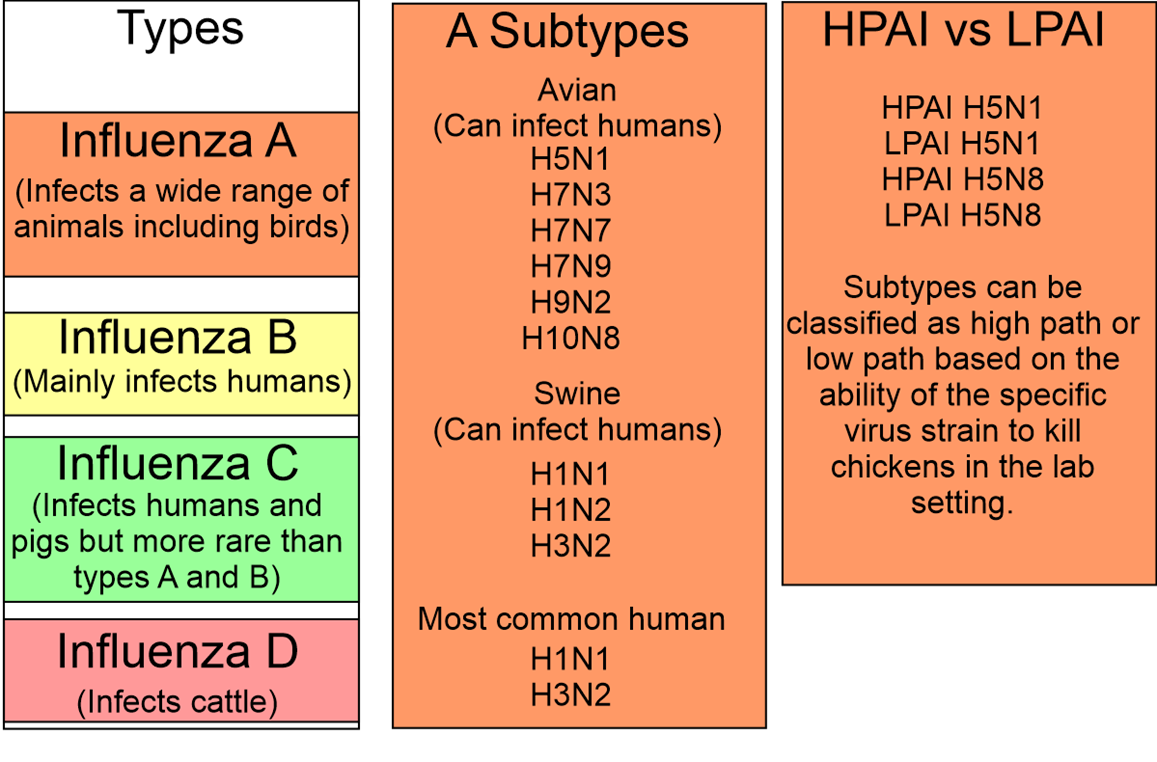Important Facts For Prelims
Avian Influenza
- 26 Oct 2023
- 5 min read
Why in News?
A recent study has shed light on significant shifts in the ecology and evolution of highly pathogenic avian H5 influenza viruses, revealing a change in their global distribution.
- These viruses have been of growing concern due to their potential impact on both avian and mammalian populations, including humans.
What are the Major Findings of the Study?
- While the epicenter of these viruses was originally confined to Asia, the study's findings suggest that this epicenter has now expanded to include new regions in Africa and Europe.
- The two H5 strains originating from African and European bird populations were found to have evolved through genetic reassortment with low pathogenic viral variants as they spread.
- This genetic reassortment is a critical factor driving the evolution and diversification of these viruses.
- The study underlined that the increasing persistence of avian influenza in wild bird populations is a catalyst for the evolution and spread of new viral strains.
- Wild birds play a crucial role in transmitting and amplifying these viruses, contributing to their ongoing evolution.
What is Genetic Reassortment?
- Genetic reassortment is a type of genetic recombination that occurs when genes from two organisms are mixed to create a new genetic sequence. This new sequence is called a recombinant.
- It can increase genetic diversity during the evolution of seasonal viruses. It can also lead to novel and potentially deadly viruses.
What is Avian Influenza?
- About:
- Avian influenza, often referred to as bird flu, is a highly contagious viral infection that primarily affects birds, particularly wild birds and domestic poultry.
- In 1996, highly pathogenic avian influenza H5N1 virus was first identified in domestic waterfowl in Southern China. The virus is named A/goose/Guangdong/1/1996.
- Transmission to Humans and Related Symptoms:
- Human cases of H5N1 avian influenza occur occasionally, but it is difficult to transmit the infection from person to person. As per World Health Organisation(WHO), when people do become infected, the mortality rate is about 60%.
- It can range from mild flu-like symptoms, including fever, cough, and muscle aches, to severe respiratory issues like pneumonia, difficulty breathing, and even cognitive problems such as altered mental status and seizures.
- Human cases of H5N1 avian influenza occur occasionally, but it is difficult to transmit the infection from person to person. As per World Health Organisation(WHO), when people do become infected, the mortality rate is about 60%.
- Avian Influenza and India:
- Initial Outbreak:
- The initial outbreak of Highly Pathogenic Avian Influenza (HPAI) H5N1 in India occurred in 2006 in Navapur, Maharashtra, and was followed by annual outbreaks.
- H5N8 was first observed in India in November 2016, mainly affecting wild birds across five states, with Kerala reporting the most cases.
- The disease has been reported in 24 states and union territories, resulting in the culling of over 9 million birds to control its spread.
- Related Initiative:
- India's approach to controlling Highly Pathogenic Avian Influenza (HPAI) follows a "detect and cull" policy as outlined in the National Action Plan for Prevention, Control, and Containment of Avian Influenza (revised - 2021)
- Initial Outbreak:
- Treatment:
- Antivirals have demonstrated effectiveness in the treatment of avian influenza virus infections in humans, lowering severity and the risk of death.
What are the Types of Influenza Virus?
Note
HPAI stands for Highly Pathogenic Avian Influenza and LPAI stands for Low Pathogenic Avian Influenza
UPSC Civil Services Examination, Previous Year Question (PYQ)
Q. H1N1 virus is sometimes mentioned in the news with reference to which one of the following diseases? (2015)
(a) AIDS
(b) Bird flu
(c) Dengue
(d) Swine flu
Ans: (d)





